Explore the Sacred Beauty of Kasuga Grand Shrine in Nara: A Must-Visit Destination
Nestled in the heart of Nara, Kasuga Grand Shrine (Kasuga Taisha) stands as a timeless testament to Japan’s spiritual heritage. Renowned for its stunning vermilion structures, serene forest pathways, and thousands of lanterns, Kasuga Grand Shrine is one of Nara’s most cherished and iconic landmarks. This article aims to unveil the unique charm of Kasuga Grand Shrine and inspire your next visit to this sacred site.
- Kasuga Grand Shrine: A Sacred Haven in Nara
- The Mystical Path: Walking Through the Ancient Forest
- Inside Kasuga Grand Shrine: Discovering Its Hidden Gems
- Seasonal Festivals and Events at Kasuga Grand Shrine
- Practical Tips for Visiting Kasuga Grand Shrine
- Exploring Beyond Kasuga Grand Shrine: Making the Most of Your Nara Visit
- Conclusion
Kasuga Grand Shrine: A Sacred Haven in Nara
History and Significance
Kasuga Grand Shrine, founded in 768 AD, is dedicated to the deity responsible for the protection of Nara and the prosperity of its people. The shrine is deeply intertwined with the Fujiwara clan, one of Japan’s most powerful aristocratic families during the Heian period. Today, Kasuga Taisha remains a site of worship and cultural heritage, attracting visitors from around the world.
Architectural Style and Layout
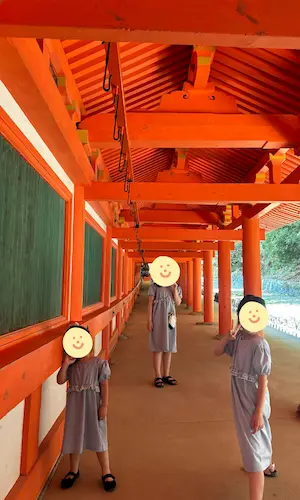
The shrine is famous for its vibrant vermilion buildings, which stand in striking contrast to the surrounding greenery. It features a unique architectural style known as “Kasuga-zukuri,” characterized by gracefully curved roofs and intricate woodwork. The complex is adorned with numerous stone and bronze lanterns, which create a mesmerizing atmosphere, especially during the Lantern Festivals.
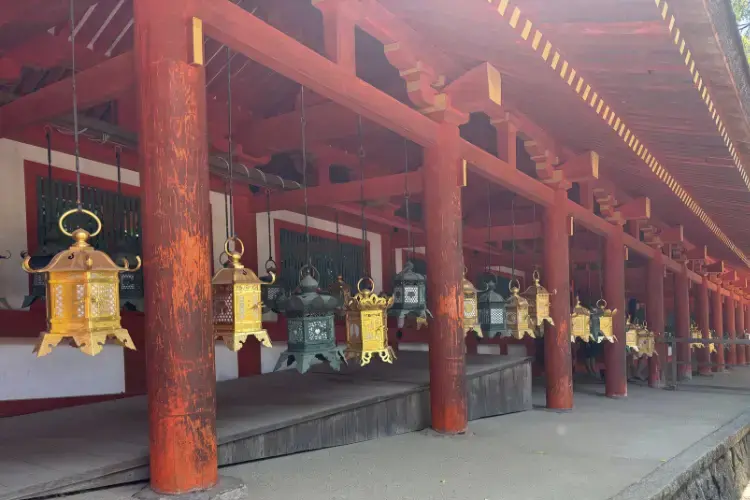
Unique Aspects of the Shrine
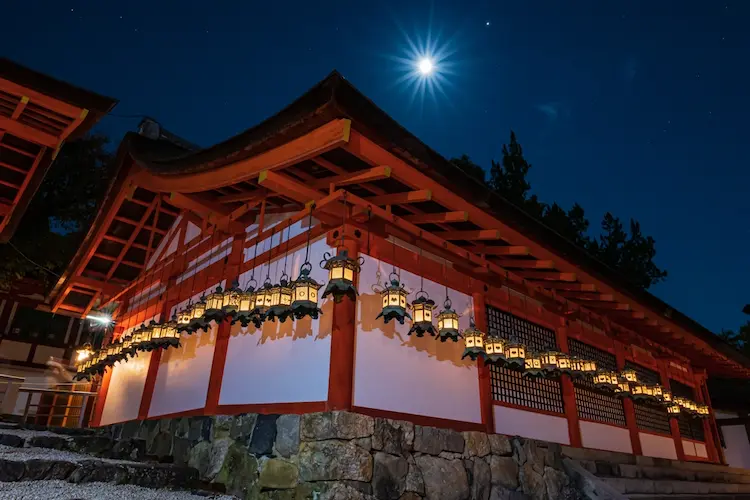
One of the most distinctive features of Kasuga Grand Shrine is its lanterns—over 3,000 of them, including both stone lanterns lining the approach and bronze lanterns hanging throughout the shrine grounds. These lanterns are lit during the Mantoro (Lantern Festival), held twice a year, creating a magical spectacle.
The Mystical Path: Walking Through the Ancient Forest
Introduction to the Primeval Forest
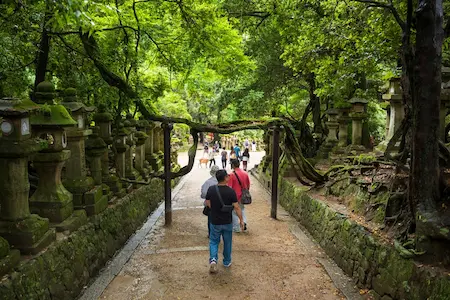
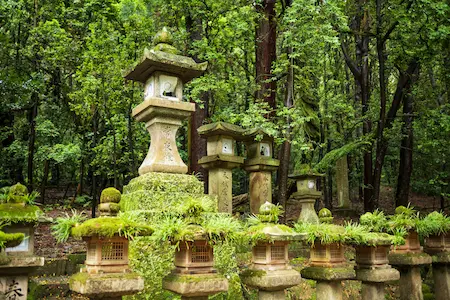
Kasuga Grand Shrine is surrounded by Kasugayama Primeval Forest, a sacred grove that has remained untouched for over a thousand years. Walking through this ancient forest feels like stepping into another world, where towering cedar and cypress trees whisper tales of Japan’s past.
The Spiritual and Cultural Importance of the Forest
The forest is considered sacred, as it has been protected as part of the shrine grounds since the Heian period. It symbolizes the deep connection between Shinto beliefs and nature, reflecting the idea that gods inhabit all elements of the natural world.
Personal Experience: Walking Through the Forest
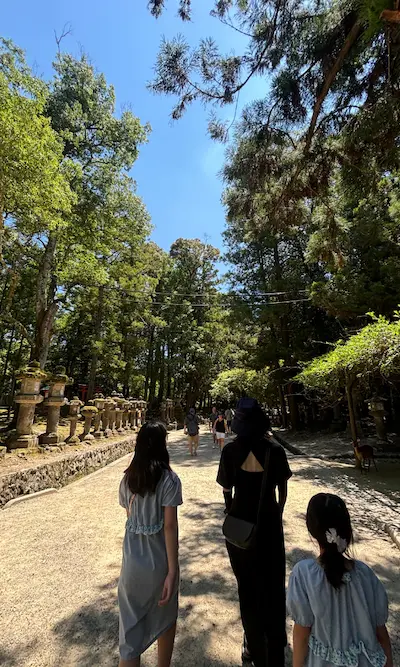
On my visit to Kasuga Grand Shrine, I walked through this mystical forest. Even without any spiritual inclination, I felt a profound sense of calm and sacredness. The towering trees, the fresh, earthy scent, and the quiet rustling of leaves underfoot created an atmosphere that was both peaceful and awe-inspiring.
Tips for Visitors
- Wear Comfortable Shoes: The path can be uneven, so sturdy footwear is recommended.
- Take Your Time: Pause often to take in the natural beauty and quietude.
- Respect the Environment: As the forest is considered sacred, do not remove any plants or disturb the wildlife.
Inside Kasuga Grand Shrine: Discovering Its Hidden Gems
The Vivid Contrast of Colors
Upon entering the shrine grounds, you are immediately struck by the vivid vermilion hues of the shrine buildings against the backdrop of the lush green forest. This contrast enhances the visual appeal and reinforces the spiritual ambiance of the shrine.
The Inner Sanctuary and Lantern Room
The inner sanctuary of Kasuga Grand Shrine is where the true magic happens. As you venture deeper into the complex, you will find a dimly lit room filled with intricately designed lanterns. This lantern room is a hidden gem that offers a tranquil and almost otherworldly atmosphere. The soft glow of the lanterns illuminates the dark space, casting gentle shadows that dance across the walls, creating a serene and enchanting experience.
Why You Must Visit the Lantern Room:
- The lantern room provides a unique opportunity to experience the spiritual aura of the shrine.
- It is a perfect spot for quiet reflection and appreciating the artistry of the lanterns.
Seasonal Festivals and Events at Kasuga Grand Shrine
Kasuga Wakamiya On-Matsuri
Held every December, the Kasuga Wakamiya On-Matsuri is a lively festival that celebrates the shrine’s rich history and traditions. The event features traditional music, dance, and processions that bring the shrine’s ancient culture to life.
Lantern Festivals (Mantoro)
The Lantern Festivals, held twice a year in February and August, are among the most popular events at Kasuga Grand Shrine. During these festivals, thousands of lanterns are lit, transforming the shrine into a magical wonderland of lights. The warm, flickering lanterns against the backdrop of the night sky offer a mesmerizing sight that leaves a lasting impression.
Practical Tips for Visiting Kasuga Grand Shrine
Best Times to Visit to Avoid Crowds
To enjoy the shrine in a more tranquil setting, visit early in the morning or late in the afternoon. Weekdays are generally less crowded than weekends, providing a more serene experience.
How to Get to Kasuga Grand Shrine from Major Cities
- From Kyoto: Take the JR Nara Line from Kyoto Station to Nara Station (approximately 45 minutes), then a short bus ride or 20-minute walk to the shrine.
- From Osaka: Use the Kintetsu Nara Line from Osaka-Namba Station to Kintetsu Nara Station (about 40 minutes), followed by a 10-minute walk to the shrine.
Recommendations for Nearby Places to Explore After Visiting the Shrine
- Todaiji Temple: Famous for the Great Buddha, just a short walk away.
- Nara Park: A beautiful place to relax and interact with the deer.
- Naramachi: A historic district with charming old merchant houses and local shops.
Etiquette and Guidelines for Visitors
- Dress Modestly: Respectful attire is recommended when visiting sacred sites.
- Quiet Conduct: Keep noise levels down and respect those who are there to worship.
- Photography: Be mindful of areas where photography may be restricted, particularly within the inner sanctuaries.
Exploring Beyond Kasuga Grand Shrine: Making the Most of Your Nara Visit
Other Nearby Attractions to Complement Your Visit
- Todaiji Temple: Home to the Great Buddha and a UNESCO World Heritage Site.
- Nara Park: Famous for its deer and beautiful landscapes.
- Naramachi: An area filled with traditional Japanese architecture and quaint shops.
Suggested Itineraries for a Day Trip or Extended Stay in Nara
- Day Trip Itinerary:
- Begin with a visit to Kasuga Grand Shrine.
- Walk to Todaiji Temple to see the Great Buddha.
- Enjoy lunch at a local restaurant.
- Explore Nara Park and feed the deer.
- Conclude with a stroll through Naramachi before heading back.
- Extended Stay Itinerary:
- Spend additional days exploring lesser-known temples, enjoying local delicacies, and attending seasonal festivals.
Conclusion
Kasuga Grand Shrine is a sacred gem in Nara, offering a unique combination of spiritual ambiance, natural beauty, and historical importance. Whether you’re exploring the mystical forest path, marveling at the vibrant shrine buildings, or enjoying the tranquil glow of the lantern room, Kasuga Grand Shrine promises an unforgettable experience. Plan your visit to Nara and discover the spiritual charm of Kasuga Grand Shrine for yourself. Share your experiences and let this sacred place inspire your journey through Japan.









